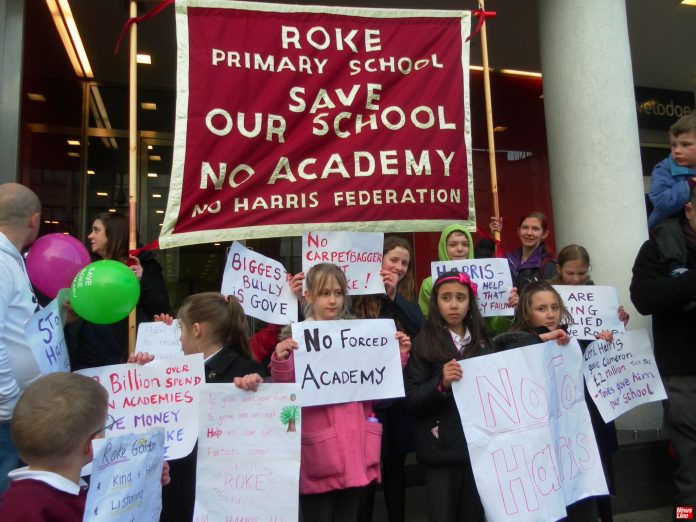
Education unions in the UK have reaffirmed the urgent need to protect students and education workers from asbestos in schools, demanding that ‘all asbestos must be removed from all schools’.
‘The NASUWT is deeply troubled to see that in yet another school, asbestos has been removed unsafely,’ said National Association of Schoolmasters Union of Women Teachers (NASUWT) General Secretary Chris Keates on Tuesday.
She was commenting on a fine issued to a construction company after sub-contractors were exposed to asbestos while refurbishing Oakwood Junior School in Derby.
She continued: ‘While the prosecution and the fine are welcome, this incident should not have happened in the first place.’
She insisted: ‘The NASUWT has stated consistently that the management of asbestos in situ is flawed and all asbestos must be removed from all schools to prevent these cases occurring.’
She went on to warn: ‘If this work had been undertaken in term time, the outcome could have been much more serious, with potentially large numbers of pupils and teachers contaminated.
‘The NASUWT is also concerned that Derby City Council appears to have learned very little from the Silverhill prosecution in 2007, in which the NASUWT was a key witness in securing the prosecution,’ she added.
Keates continued to say: ‘The government and employers should be taking a more proactive approach to the safety and welfare of pupils and staff.’
The National Education Union (NEU), recalled that the Health and Safety Executive (HSE), the UK government agency responsible for the encouragement, regulation and enforcement of workplace health, safety and welfare, and for research into occupational risks, approved a Code of Practice on the Control of Asbestos Regulations stating that the duty holder under the regulations will be ‘the person in control of maintenance activities’ at the premises.
An NEU spokesman warned: ‘In maintained schools and academies, financial control of school budgets for routine maintenance, and in some cases structural works, is delegated to the governing body.
‘The principal responsibility under the regulations for ensuring that asbestos is identified and managed therefore also rests with the employer.
‘The NEU has concerns that moves towards mass academisation and an increasing number of employers will affect asbestos management in schools.
‘When schools become academies, they lose the support of the local authority as duty holder.
‘While some academy trusts will be experienced in asbestos management, many, especially small trusts, will not.
‘This could lead to poor asbestos management practices.’
The NEU also said it believes that asbestos surveys should be carried out in all schools unless there is good reason not to do so, and duty holders must prepare written plans setting out how the risks from any potential asbestos materials are to be managed.
These management plans should in all cases provide information about the location and condition of presumed asbestos and be distributed to all employees, to others who are liable to disturb it and to the emergency services.
Duty holders should take immediate action to deal with identified damaged/disturbed materials before preparing their plans, and put safe systems of work in place to prevent disturbance of potential asbestos materials.
There should also be full consultation between the employer, the school leader and all safety representatives.
NEU safety representatives should be involved in all such discussions even if the asbestos is found in an area where NEU members do not work, such as the boiler room, since errors in removal might result in asbestos contamination of a far wider area of the school.
Asbestos is a naturally occurring soft fibrous mineral.
All types of asbestos are classified as class 1 carcinogens.
It has been used widely for many years due to its properties of resistance to heat and chemicals.
Many thousands of tonnes have been used in construction of public buildings and, although the use of most types of asbestos has been banned, much asbestos is still present in buildings.
In March 2017, the Department for Education published guidance for schools on where asbestos may be located.
The risks in schools are clear.
Asbestos was widely used in constructing schools in the past but poor structural maintenance and vandalism make schools more vulnerable than other buildings to the risk of release of asbestos fibres.
These very small and fine asbestos fibres can be breathed in easily, and remain in the lungs or settle in the linings of the lungs and the chest cavity, for long periods after exposure.
Their presence can lead to many asbestos-related diseases.
- More than 80% of council-run schools in Birmingham could contain asbestos.
A freedom of information request made to the city council revealed last Thursday that 161 of the 192 schools it is responsible for have the potential to contain the material.
The council said there was no need for ‘undue concern’.
‘There is always a chance that any building built before 2000 may contain asbestos,’ a spokesman said.
Asbestos gives off fine fibres which can be breathed in and remain in the lungs potentially leading to diseases such as lung cancer.
Responding to the figures obtained by the Local Democracy Reporting Service, councillor Ken Wood, said: ‘Whilst it is understandable that parents may be concerned by these statistics, the Health and Safety Executive (HSE) are clear that as long as asbestos is in good condition and is not disturbed or damaged there is negligible risk.
‘There is no reason for anyone to be unduly concerned,’ he added.
Of the 192 schools, 164 are local authority owned and maintained, while 28 are local authority maintained but not owned by the council.
Nationally, at least 319 school teachers have died from mesothelioma since 1980, with 205 of those occurring since 2001, the National Education Union says.
The city council said it would not be naming the schools involved.